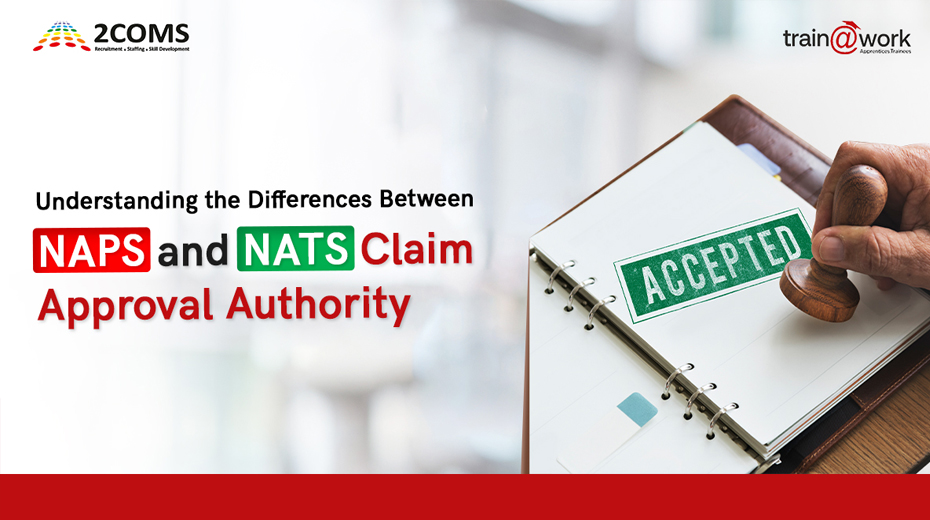Unravel the intricacies of NAPS and NATS! Dive into the realm of apprenticeship, decode their differences, and discover the claim's approving authorities.
In an effort to equip the youth of India with employable skills, several programs have been developed. The National Apprenticeship Promotion Scheme (NAPS) and the National Apprenticeship Training Scheme (NATS) are effective initiatives. Both aim to enhance skills through apprenticeships, but their operational frameworks and claim-approving authorities are significantly different. In this blog, we'll compare and contrast these two remarkable schemes.
Despite being subject to the 1962 Apprenticeship Act's regulations, did you know that NAPS and NATS have separate ministries in charge of their administration?
Understand the Differences Between NAPS and NATS
A government program called National Apprenticeship Promotion Scheme (NAPS), introduced in 2016. It offers financial incentives to businesses and sectors for hiring apprentices. It encourages apprenticeship education and raises the number of actively engaged apprentices from roughly 2.3 lakhs to 50 lakhs. However, the Board of Apprenticeship Training/Practical Training established the one-year National Apprenticeship Training Scheme (NATS) program. Its main objective is to close the academic achievement gap between -
- 10+2 Vocational
- Diploma
- Engineering students
- The educational needs of the industry.
The Claim Approval Authority is a significant distinction between these two programs. It is the entity in charge of authorizing and distributing financial incentives to participating businesses.
Claim Approving Authority of NAPS
In the case of National Apprenticeship Promotion Scheme (NAPS), the Claim Approving Authority is the Director General of Training (DGT). The DGT works under the Ministry of Skill Development and Entrepreneurship (MSDE). The National Skill Development Corporation (NSDC), which answers to MSDE, monitors how NAPS is used as a whole.
NSDC has given the Sector Skill Councils (SSC) a lot of critical practical tasks. The SSC, also called the "apprentice advisor,". The SSC will be the first person to decide whether a NAPS reimbursement claim is valid. When the SSC approves a claim, it is sent to the NSDC for final approval and money to be sent out. Through the DGT, the MSDE gives all employers 25% of the specified stipend, up to a maximum of INR 1,500 per apprentice per month. The companies provide the apprentices with their stipends, which they can then get back from the DGT.
Claim Approving Authority of NATS
In contrast, depending on the region, the Board of Practical Training (BOPT) or the Board of Apprenticeship Training (BOAT) approved National Apprenticeship Training Scheme (NATS) (NATS's) claim. The Ministry of Education (previously HRD) is responsible for running these boards. They are significant to the success of NATS because they coordinate the program with businesses and educational institutions and help with job training.
The country is divided into four zones. The BOPT offices are in the eastern part of India, in Kolkata. The BOAT is in charge of the last three zones. The BOPT/BOAT is in charge of handling and distributing all NATS-related claims.
Both plans are meant to improve India's skills but are aimed at slightly different groups. NAPS wants to train semi-skilled and unskilled people by focusing on practical training. On the other hand, NATS mainly works with students who have finished their engineering, diploma, or vocational courses. And providing them with commercial experiences and exposure.
Also, the length of the job training is different between the two programs. Depending on the trade, the NAPS apprenticeship time can last anywhere from six months to two years. On the other hand, all of the job programs at NATS last for one year.
In summary, the National Apprenticeship Promotion Scheme and the National Apprenticeship Training Scheme are crucial in driving India's skill development mission. These schemes are like two sides of a coin, complementing each other and creating a robust framework for skill development in India. They are the twin stars guiding the youth toward a brighter future, empowering them with the skills needed. The programs are navigating the complex labyrinth of the professional world. By understanding these differences and capitalizing on them, we can better harness the potential of our youth, creating a robust workforce ready to meet the future's challenges. They are not just schemes but stepping stones to a more skilled, capable, and self-reliant India.
Collaborate with 2COMS to navigate the complexities of NAPS and NATS claim approvals. Our experts elucidate the interface between these two authorities, breaking down their functions and processes to help you attain swift approvals. Join our quest for better understanding, mitigating claim concerns and fostering smooth operations. Trust 2COMS - your reliable guide in the realm of NAPS and NATS claim approvals. Get on board for streamlined processes and hassle-free approvals! For detailed insights, visit our website
https://www.2coms.com/solutions/apprenticeship-management



























